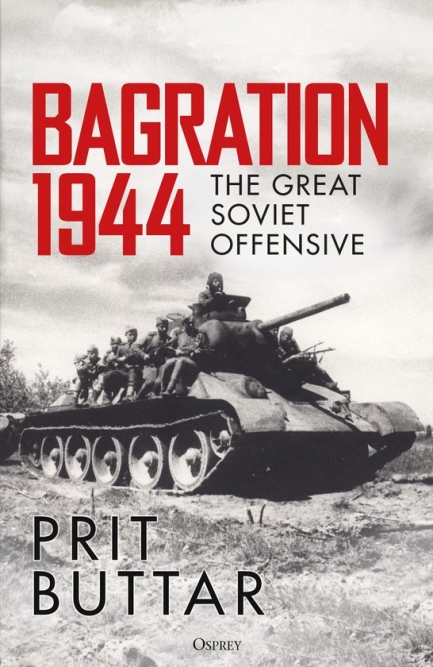| Title: | Bagration 1944 - The Great Soviet Offensive |
| Writer: | Buttar, Prit |
| Published: | Osprey Publishing |
| Published in: | 2025 |
| Pages: | 488 |
| ISBN: | 9781472863485 |
| Description: | Prit Buttar, originally trained as a physician, developed into a prolific author after a career in the British Army, particularly writing military history books on the First and Second World Wars. His two most recent studies focused on the years-long, bloody siege of Leningrad (starting in 1941) by the Germans and the eventual liberation of the city by the Red Army in 1944. In this new book, Bagration 1944, Buttar examines the massive and highly successful Russian offensive, "Operation Bagration," which, between late June 1944 and mid-August 1944, broke the backbone of the German Army Group Centre. This large-scale offensive liberated Belarus and enabled the Red Army to advance into the Baltic states and as far as the Polish capital, Warsaw, while even bringing the German border in East Prussia into sight. Operation Bagration – named after Tsarist General Pyotr Bagration, who had fought against Napoleon – was the most successful Russian campaign of the Second World War. This campaign, in terms of scope and execution, can be compared to the German Operation Barbarossa – the invasion of the Soviet Union that began on June 22, 1941. Similarly, Operation Bagration, which was launched on June 22, 1944 (a date likely not chosen by coincidence), involved a "Blitzkrieg" strategy in which armored units, supported by dive bombers and artillery, rapidly broke through enemy defenses. With deliberate disregard for their flanks, they drove deep into the rear, creating massive encirclements. Additionally, Operation Bagration allowed for a degree of operational freedom among Russian commanding officers, who were permitted to exploit emerging opportunities in response to the constantly shifting battlefield conditions. Once the offensive began, an interesting paradox developed – a point also noted by Buttar – whereby the Red Army of 1944 resembled the Wehrmacht of three years earlier, while Hitler made the same fatal mistakes that Stalin and the Soviet High Command had committed in 1941. First and foremost, the distrustful Führer denied his generals the right to act on their own initiative. He demanded blind obedience to orders – just as Stalin had in 1941. Furthermore, Hitler deprived his commanders of the ability to maneuver, as he insisted on holding onto every piece of previously conquered territory. He even designated several Russian cities as fortresses ("fester Platz") that had to be defended at all costs. The results of this strategy were catastrophic: the rapidly advancing Russian tank brigades simply bypassed these hastily established "fortresses," leaving the German units there cut off and doomed to destruction. By the time the encircled German troops were finally granted permission – after much pleading from their generals – to break out, the front line had already moved significantly westward. Only very small, scattered groups of German rückkämpfer (retreating fighters) managed to reach their own lines after enduring extreme hardships – something vividly described by military historian and veteran Rolf Hinze. Buttar highlights that German losses during Operation Bagration were even greater than those at Stalingrad. He estimates the number of German dead between 375,000 and 540,000, with the Red Army capturing around 150,000 prisoners. Before the offensive, the Wehrmacht had deployed a total of 28 divisions within the Third and Fourth Panzer Armies and the Ninth Army. After the Russian assault, only about six divisions remained. No fewer than 22 generals were forced to surrender. The Red Army itself also suffered enormous losses in both personnel and equipment, surpassing even the German casualties. However, unlike Nazi Germany, the Soviet Union was able to replenish these losses – not only in manpower but also in material – thanks to large-scale supplies from the United States. As in his previous books on the Battle of Leningrad, Buttar once again presents a well-balanced combination of military-tactical analysis and personal accounts from both German and Russian soldiers, delivered in an engaging writing style. In addition to his chronological account, he also includes sections on the conspiracy against Hitler and the Warsaw Uprising. For those with little prior knowledge of the Eastern Front, this book is highly recommended, while even more knowledgeable readers will appreciate this well-structured historical narrative. |
| Rating: |     Very good Very good |
Information
- Article by:
- Jan-Jaap van den Berg
- Published on:
- 09-04-2025
- Feedback?
- Send it!
Images


